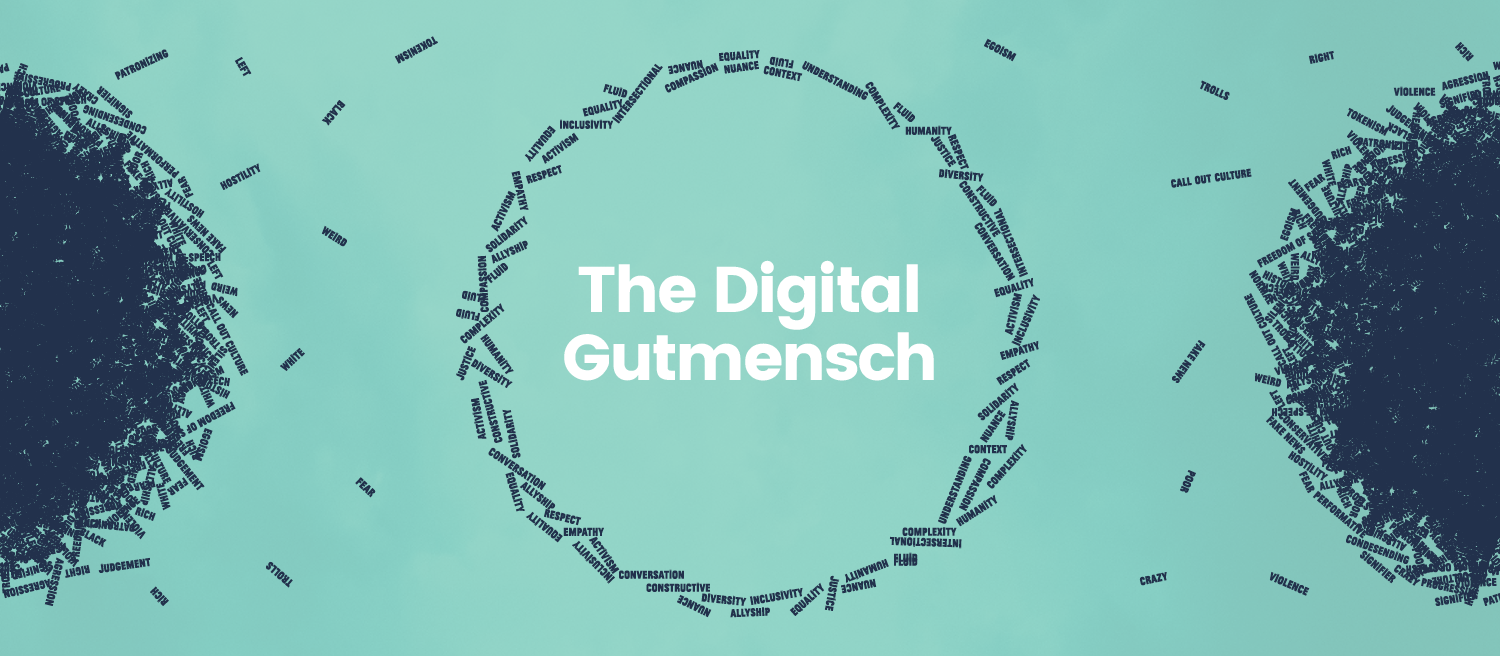“Visibility which makes us most vulnerable is that which also is the source of our greatest strength; […] to define ourselves, name ourselves, and speak for ourselves, instead of being defined and spoken for by others.” – Audre Lorde
Who would not want to live in a world where people are not put in box and could live without a label? A world where humans would just be humans? It would be a dream to live in a utopia where definitions and categorizations are no longer needed. However, various stigmas that have tactical consequences for marginalized groups are very much present in our society. Until these issues are resolved, we, unfortunately, still need definitions to be able address these issues adequately.
Michel Foucault explains in The Order of Things that human language is a demonstration of the human mind which slowly changes through time and through cultural exchange, just like the cycle of human beliefs. Language and definitions are present in all aspects of our society, and therefore it is important to investigate the underlying power structures in defining accepted terminologies. Language is power. And those who have to power to define decide what the norm looks like. In order to change that norm from an oppressive into an inclusive one, marginalized groups are currently taking their agency back by defining themselves, instead of being defined by the status quo, using Instagram Infographics as their weapon of choice.
Instagram Infographics
Hannah Berman claims that the Instagram Infographic trend, that emerged in the wake of George Floyd’s murder, should receive more attention. According to her, Instagram Infographics are uniquely capable of transmitting information and are therefore a powerful political tool. Owen Jones, in his article about millennials and generation Z turning their backs on capitalism, also illustrates that political information being shared in a simplified way on social media has opened users’ eyes about political issues such as race, identity and class – of which Instagram Infographics are a perfect example. The infographic, which was previously a top-down tool made by specialists such scientists and journalists where complex data was visualized, has been democratized and simplified into an aesthetically pleasing viral image (usually in pastel colors) that usually consist of texts, slogans and illustrations – according to Berman, anyone with an Internet connection and basic understanding of free editing tools has the capacity to create and widely share information now.
Bisexual Identity
The bisexual identity, with all its ambiguities and stereotypes is a perfect example to address the political need for defining. Through Instagram infographics, the bisexual community is currently informing peers and having discussions about their identity and experiences. Consequentially they are becoming a direct agent in defining the discourse around their existence, illustrated by the examples in Fig 1-6.
These specific Infographics have helped me a tremendous amount on a personal level, with my own coming out as a bisexual person. I do want to note that ‘coming out’ is a problematic term to begin with; as if your sexual identity is something you should hide and then tell other people about, where cisgender heterosexual people do not have to do that. When I was younger, I never felt ‘queer enough’ to be able to be allowed to call myself bisexual and there are a lot of incorrect stereotypes that held me back in embracing my identity. These infographics played a significant role in the process of me realizing the only person who is able to define my sexuality is me. No one else. As it is important to acknowledge my own perspective and my situated knowledge, it would like to take a moment state that the fact that I am a part of the bisexual community makes me suitable to look into this subject because of my emphatical knowledge on the matter, but it also makes me biased because of my personal experience.
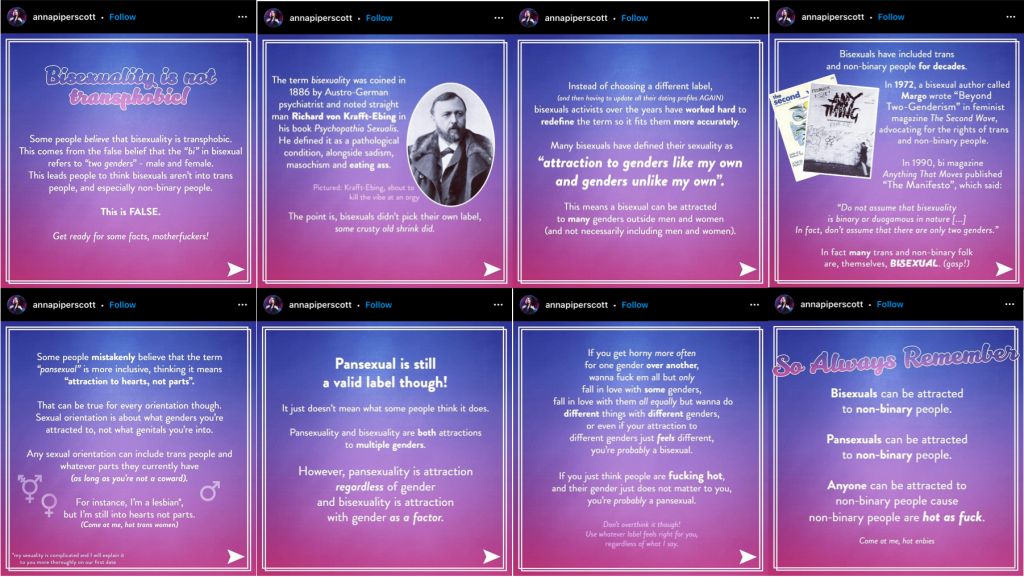
Fig. 1: Infographic by @annapiperscott discussing the incorrect believe that bisexual people are transphobic and the ontological difference between bisexuality and pansexuality.
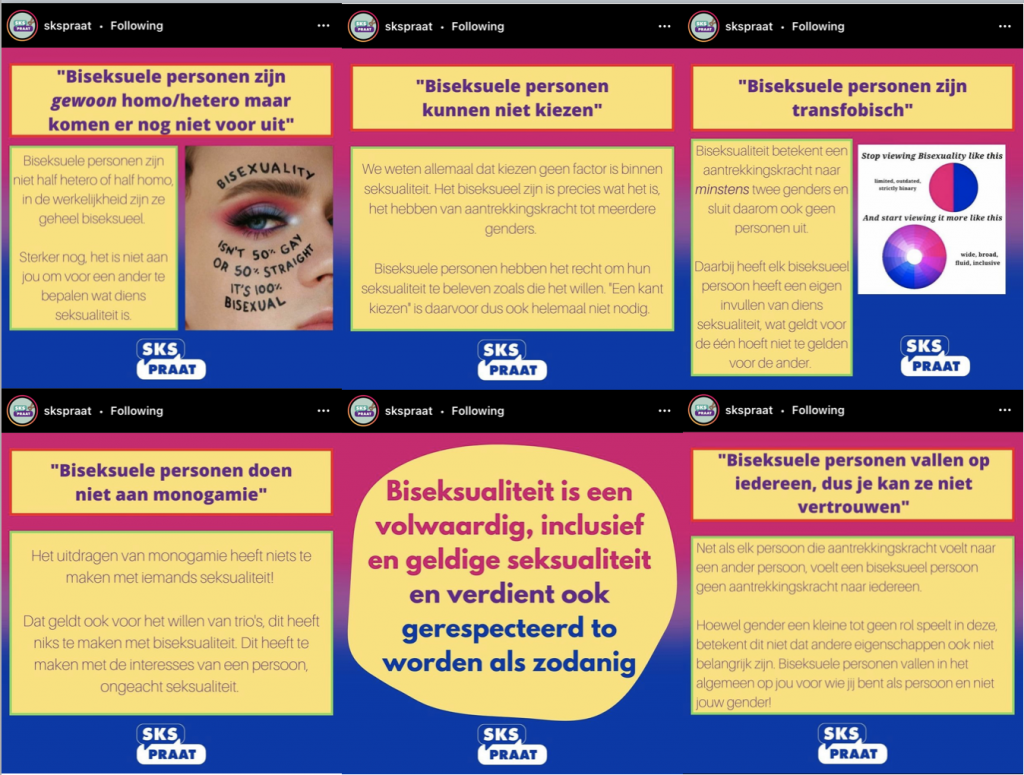
Fig. 2.1: Infographic in Dutch by @skspraat discussing incorrect assumptions about bisexual people, such as them not being able to be monogamous, to choose between genders and their sexuality being a phase, based on the input of their followers (see Fig 2.2).
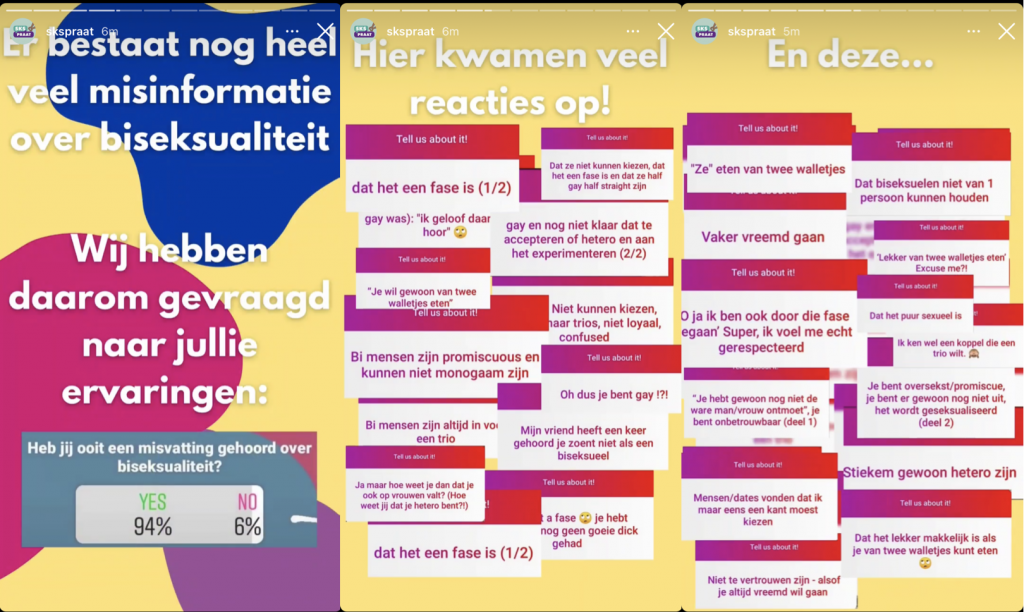
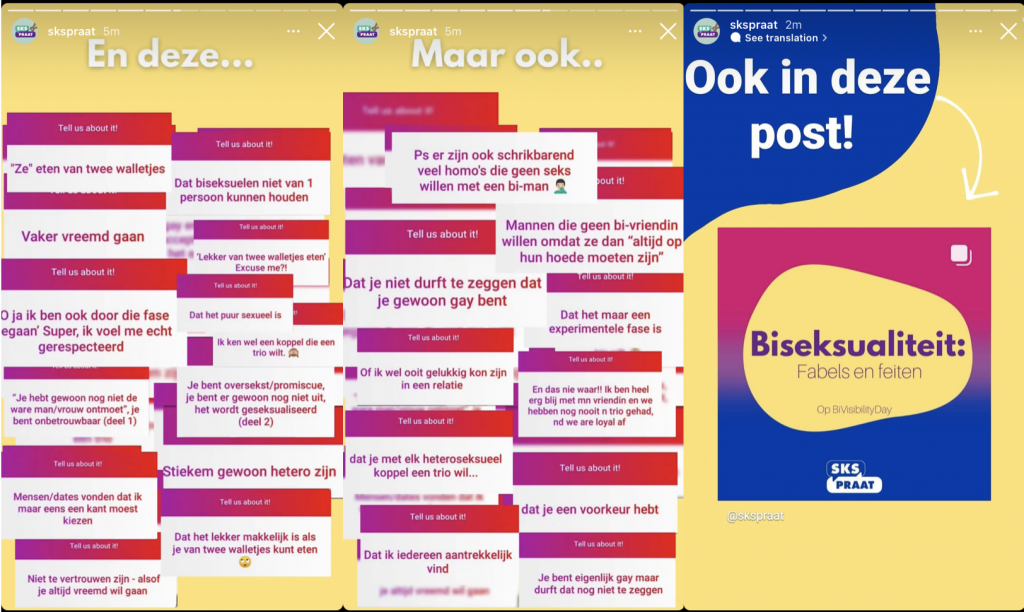
Fig. 2.2: Stories in Dutch by @skspraat sharing the input they received from their followers about incorrect assumptions about bisexual people, which resulted in an infographic (see Fig 2.1).
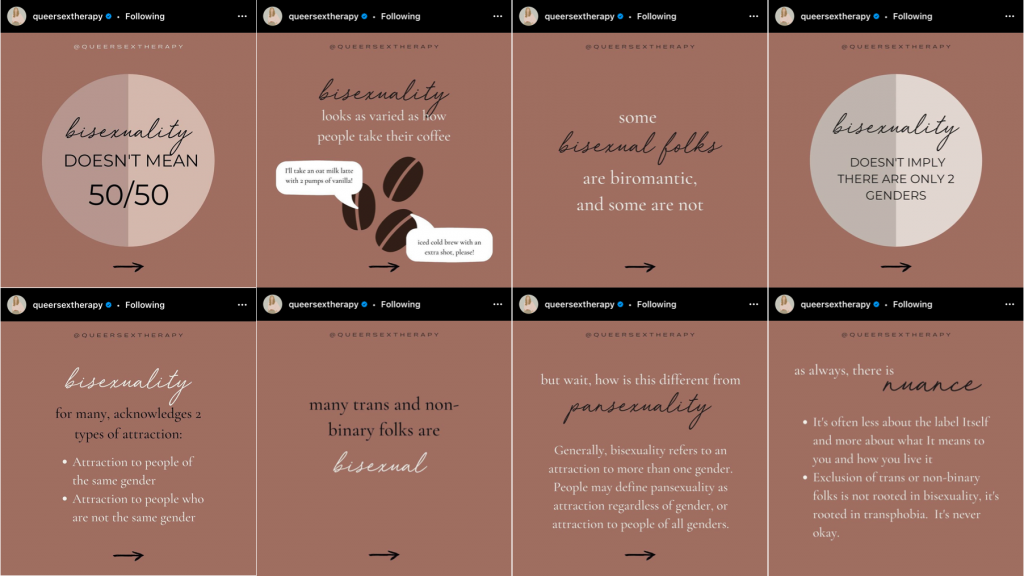
Fig. 3: Infographic by @queersextherapy about how bisexuality does not imply that there are only two genders and that binary people and trans people can be bisexual, among other subjects.
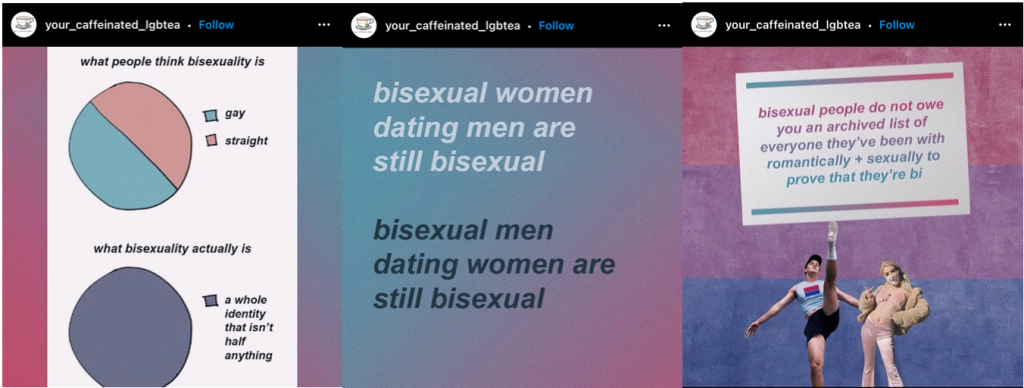
Fig. 4: Infographics by @mattixv about the different types of attraction that are possible within bisexuality and different stereotypes regarding men and women that are bisexual.
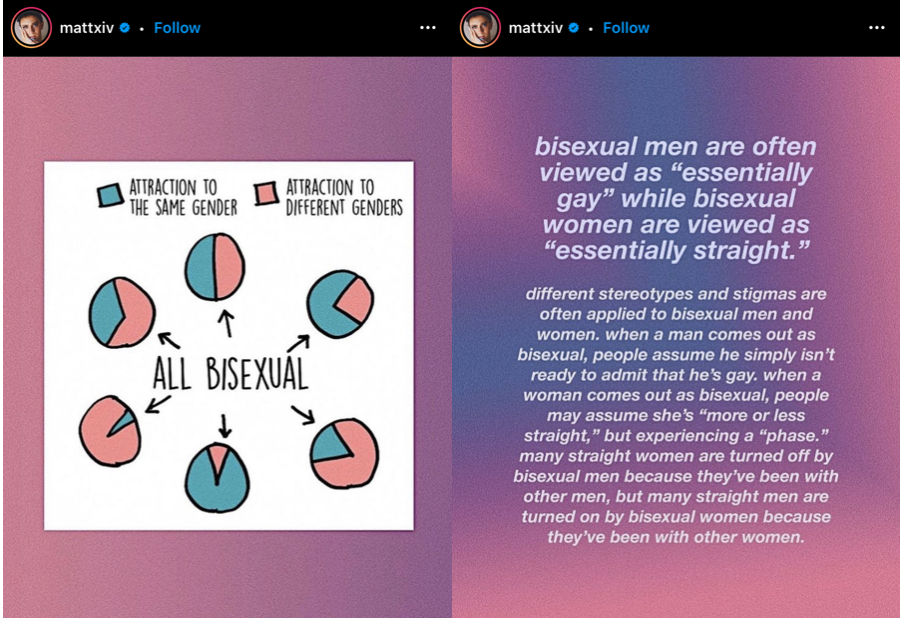
Fig. 5: Infographics by @your_caffinated_lgbtea about the bisexual identity being a valid autonomous identity that does not need to be proven with one’s history of partners.
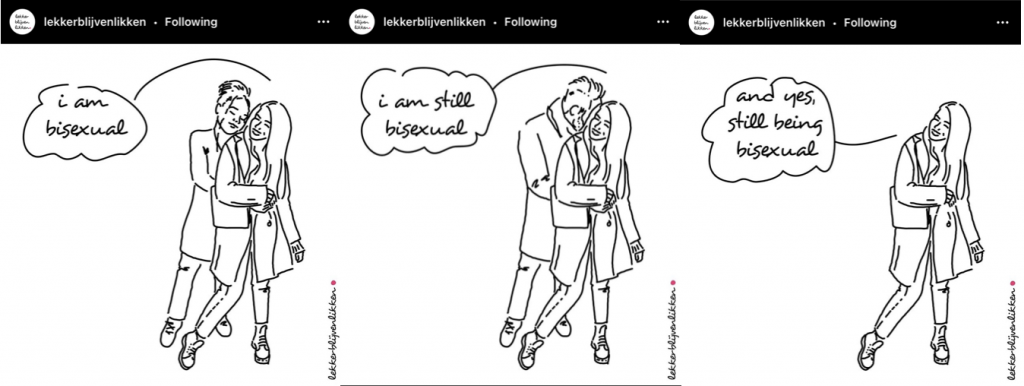
Fig. 6: Infographics by @lekkerblijvenlikken about bisexuality not being dependent on one’s current partner.
Infographics as Viral Image
Instagram Infographics are meant to be shared widely and therefore share similarities with memes. While memes are meant to be remixed and adapted by creators that usually remain anonymous, with Instagram infographics authorship is important because images are often water marked and credits are given when shared. Instagram Infographics often consist of a series of multiple images combined into one thread as well, in an attempt to make sure that the meaning does not get lost by providing enough information. This requires more space than which is needed for memes, which rely on symbols and irony and often need one image to convey a message. What memes and Infographics have in common is that they reject the logic of exclusive, elitist, top-down knowledge production and give space for a bottom-up approach, as Anahita Neghabat explains in the Critical Meme Reader. She illustrates that media shape public discourse and (re)produce hegemonic, often sexist, racist, classist or otherwise marginalizing views, masked by their veil of neutrality. Instagram Infographics, similar to memes, can be used to intervene in oppressive public discourse, because they are simple, reach a huge audience, but also stimulate critical thinking. Neghabat explains that because of the DIY aesthetic, it allows marginalized groups to create alternative representations.
The Value of Bottom-Up Knowledge Production on Instagram for Researchers
Instagram Infographics are not just relevant for the spreading of information to educate peers on political subjects, but also have value for researchers when composing an ethical terminology framework – something which is extremely important in the context of the power to define. In ‘Margins as Methods, Margins as Ethics: A Feminist Framework for Studying Online Alterity’ Rosemary Clark-Parson and Jessa Lingel explain that when studying online alterity in an ethical way, it is important to critically reflect on the power politics behind the terminology internet researchers use to describe the groups they study. They explain that to have respect for the group you are researching requires thoughtful representations of them, as the labels that are used can have repercussions for the well-being of the people that are studied. Even though Infographics may not be able to depict in depth information (more on this later), when they have a reputable cited source and when researchers have a critical attitude, as Bergman concludes, infographics can be a great starting point for ethical terminology frameworks in addition to other methods.
As explained before, Instagram Infographics are a form of bottom-up knowledge production. Let’s start taking these narratives just as seriously as peer reviewed sources. Because Instagram Infographics are a great example of what Clark-Parsons and Lingel call participatory knowledge-building practices; a method to center and include the voices of the marginalized groups that are being researched. Instagram Infographics are also publicly available, which means no power imbalance between the researcher and researched because of unnoticed lurking can occur, which is one of the ethical considerations Clark-Parsons and Lingel mention. Finally, and perhaps most importantly, no emotional labor from the marginalized group being researched, where participants potentially have to relive deeply personal experiences and potential trauma and abuse, is required, when using Infographics as a source.
The Limits of Instagram Infographics
The bottom up knowledge being produced in the form of Instagram infographics by marginalized groups, such as bisexual people, is a relevant source for researchers, in addition to it being a tool for marginalized groups to reclaim the to power to define. However, as Bergman points out, Instagram Infographics are a limited method of sharing information. She explains that because they rely on being shared widely, the information is usually simplified into eye-catching snippets, losing important context, which can lead to dangerous misunderstandings. She also states that reach and shareability seem to be more important than the reliability.
In addition, it is important to look at the power structures that are in place within Instagram. This profit driven platform is known for disadvantaging marginalized groups and progressive voices by limiting their reach or removing them from the platform entirely. While Instagram is being used as a tool by marginalized groups to define their own discourses, it also limits the way in which they can do so.
Sex Education & Pleasure Activism
When sharing Instagram Infographics about the bisexual identity and experience, Instagram does not seem to limit the way knowledge is shared. Things become blurry when it comes to infographics that discuss sexual practices, such as sex education and pleasure activism. Instagram content creators who discuss these topics have to navigate the risks of their accounts getting deleted or shadowbanned.
In this context of social media moderation we could look at flagging content and algorithmic bias, but for now I would like specifically focus on the shadowban. Carolina Are has researched the shadowban in this context and defines it as a user-generated term for Instagram’s ‘vaguely inappropriate content’ policy, which dramatically reduced posts’ visibility by hiding them from its Explore page without warning. Since 2019 Instagram hides the pictures and videos that they deem inappropriate without deleting them, preventing freelancers, artists, sex workers, activists and, largely, women, from reaching new audiences. According to Are this is a form of censorship as its limits users their speech.
Are explains that Instagram states that its community guidelines are based on providing safety and risk prevention. She continues to state that the preventative measures Instagram takes actually restricts civil liberties and that they create power imbalances with those in charge of identifying those risks and its users – usually women and queer people’s bodies. Are explains that because of the rise in hate speech and harassment affecting women, Instagram has categorized nudity, sex and sexuality as unsafe content altogether.
There are various forms which can trigger a shadowban, varying from hashtag and image censorship to caption censorship. This happens with nudity and suggestive content, but also with sex education and pleasure activist Infographics. Content creators in this realm have been navigating these risks by adjusting their content to avoid the possible repercussions, by spelling words connected to sex in alternative ways for example (see Fig 7 and 8).
Are also illustrates that Instagram’s moderation of nudity has already been condemned by artists, performers, activists after female nipples were banned, but male nipples were not, which resulted in the #freethenipple movement. Are explains that women’s bodies are still treated differently on the platform than male bodies. When sex education infographics aim to educate their followers on sexual anatomy, they are forced to use illustrations or abstract metaphors (see Fig 9).
Actively limiting the spread information about sex and pleasure shows the true colors of Instagram. It genuinely is a shame that users are deprived from information about important subjects such as consent, safe sex, the right to abortion and the orgasm gap, that could improve their sexual health.
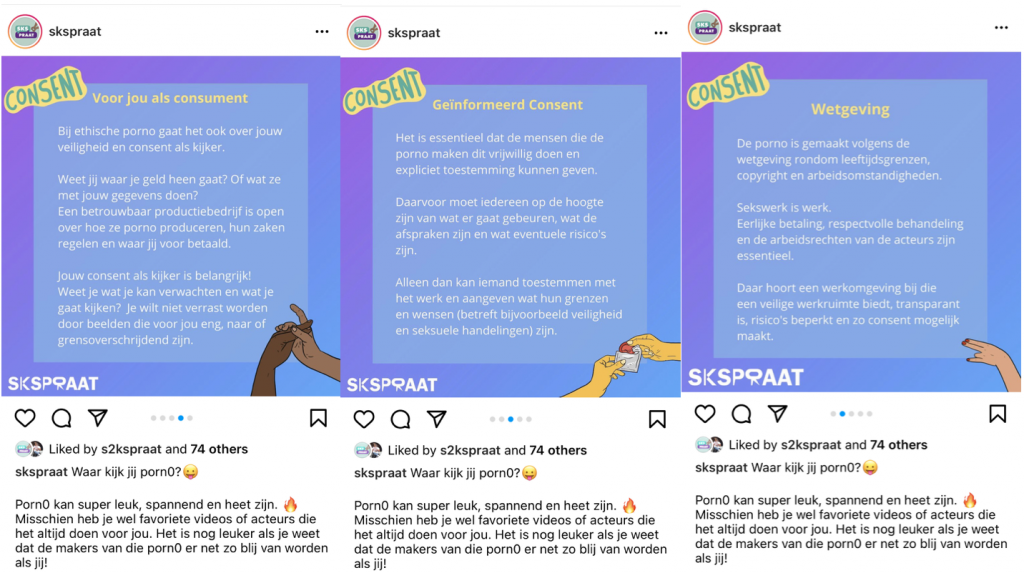
Fig. 7: Inphographics by @skspraat (note how the account is not called @sekspraat) about ethical porn consumption. ‘Porno’ (the Dutch word for porn) is spelled as ‘porn0’ in the caption.
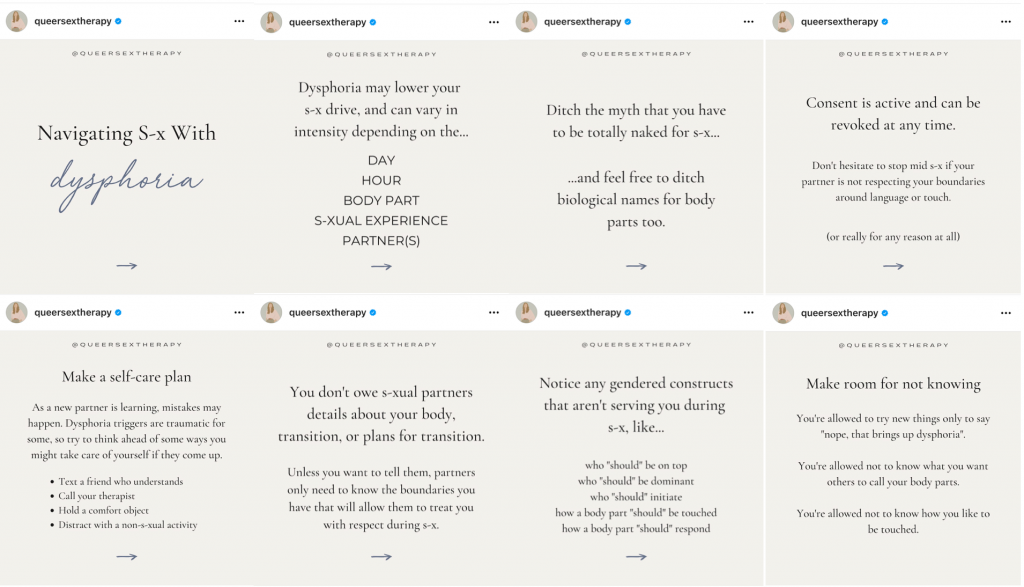
Fig. 8: Inphographics about navigating sex with body dysphoria by @queersextherapy, where all words that contain ‘sex’ are spelled with ‘s-x’.
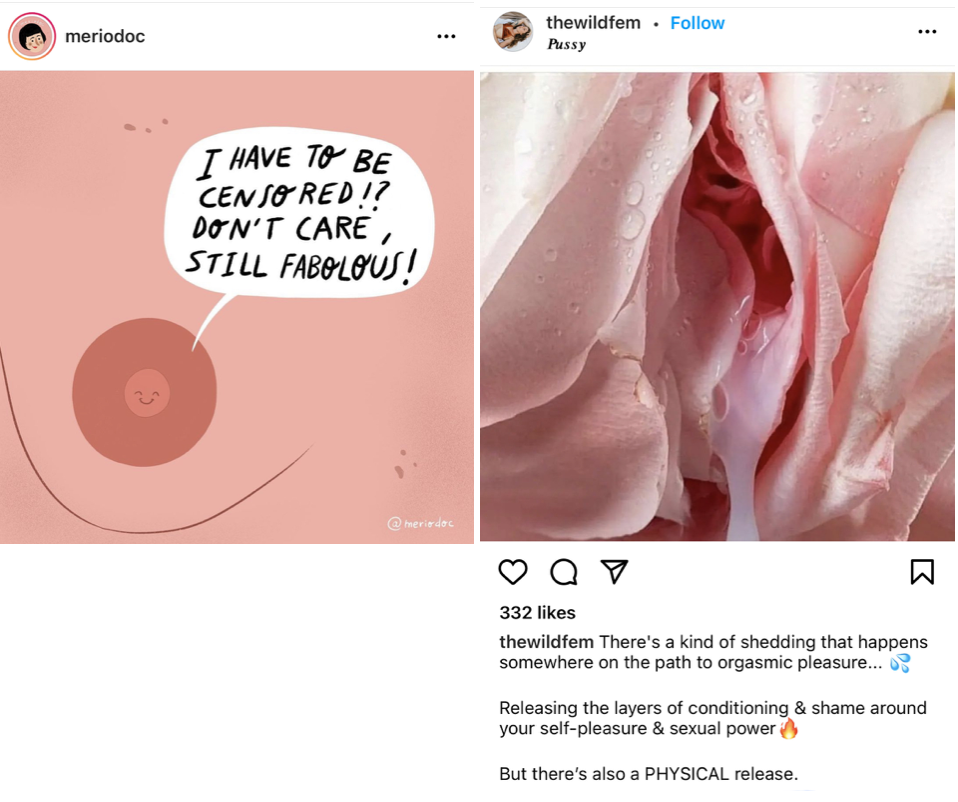
Fig. 9: Infographics by @meriodoc and @thewildfem that illustrate that when discussion female body parts in sex education on Instagram, the actual physical body parts are not allowed on the platform.
Sex Workers
Instagram’s true conservative colors become even more apparent in the case of sex workers that are active on Instagram. Instagram has taken a very clear and hostile stance against sex workers in general by regularly deleting and shadowbanning their accounts, making an already vulnerable profession even more precarious. Are explains that Instagram negatively impacts those who rely on the platform to make a living in a social media economy that thrives on visibility and its resulting opportunities. She continues by stating that social media platforms such as Instagram hold the tools to distribute this visibility and that these tools are made unequally available to users performing ‘different; actions, performing in ‘different’ kinds of labor.
Brit Dawson explains in this article celebrities and influencers are currently allowed to get away with much more explicit sexual content than sex workers are. She continues by explaining that by adding sex workers and sex traffic under the same legal umbrella, Instagram has demoralized the sex workers identity. Are states that sexist advertising seems to be welcome on Instagram, whereas progressive sexual practices are not. According to her, leaving platforms such as Instagram in charge of the visibility of women, and particularly of those that do not conform their notions of acceptability, is a form of silencing, aligning with mainstream depictions of women, nudity and sexuality, without making space for users’ own and agency.
Dawson quotes a sex worker who says that because of the fact that sex workers are erased from social media, they are cast off as ‘undesirables’ – it enforces the idea that sex workers are not valid members of society and that they do not deserve community, connection of visibility. Instagram’s policy is, as Are puts it, Othering sex workers. It comes as no surprise then, that infographics about sex workers are relatively scarce on the platform, compared to infographics about sex education and sexual pleasure, while sex work is an important part of both of these topics. Most infographic seem to be about the fact that sex work is work. Other information about sex work, that could further destigmatize the profession or help other sex workers, are hardy to be found. There seems to be no space for content like this because it does not align with Instagram’s norms.
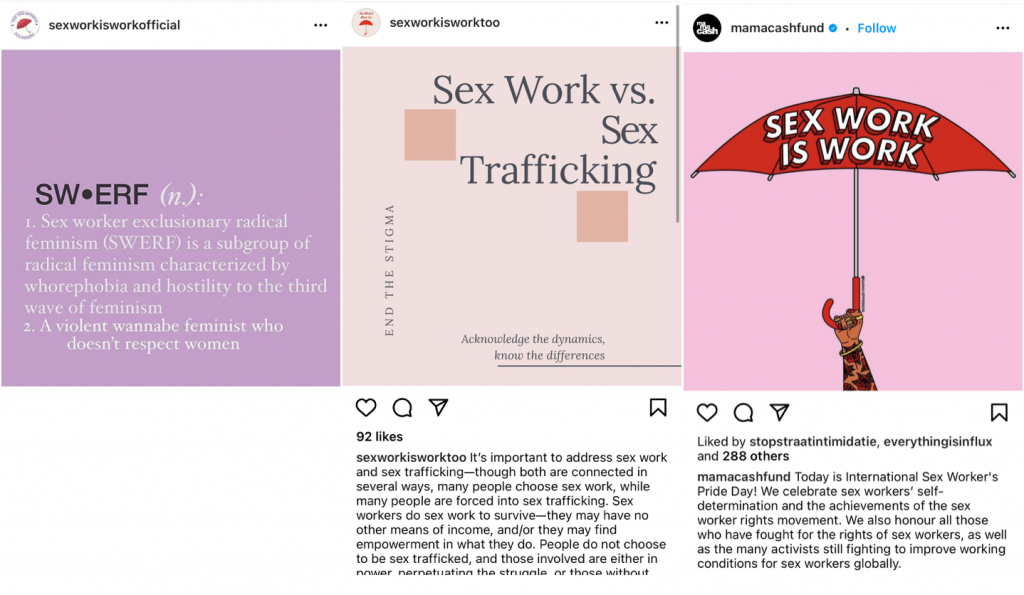
Fig. 10: Infographics about sex work being work by @sexworkisworkofficial and @mamacashfun.
Intersectional Research
Instagram infographics are not only a political tool for marginalized groups to reclaim their agency and the power to define themselves, but also a relevant source for researchers when creating an ethical terminology framework. However, the platform’s conservative ideals and its corresponding affordances imposed by the community guidelines limit the way in which marginalized groups can do so.
It is important to note that there are various other marginalized groups that share infographics and are limited by Instagram in a similar way; from anti-racist and anti-ableism activists to activists that speak out for the freedom of Palestine and the safety of people from Afghanistan. All these groups face specific problems and these should be researched accordingly, however, studying the Instagram Infographic phenomenon with an intersectional approach, connecting all these various groups, is the next step in this topic. Another next step is a cross platform analysis in this context between different platforms, such as TikTok, Twitter and Tumblr. Additionally, as Clark-Parsons and Lingel state, it is important to include the voices of the marginalized groups that are being researched. I am part of the bisexual community and a pleasure activist, however, I am not a sex educator or sex worker, so I will include their perspectives. Finally, as Are notes as well, it is important that these topics should not be discussed separately from offline privilege and inequalities.
Works cited
@annapiperscot, “It’s Bisexual Visibility Day”, Instagressam photo, September 23, 2020, https://www.instagram.com/p/CFde8guDl2p/.
Are, Carolina. 2021. “The Shadowban Cycle: an autoethnography of pole dancing, nudity and censorship on Instagram.” Feminist Media Studies 10.
Berman, Hannah, “Should We Trust Instagram Infographics? How the Infographics Recent Rise in Instagram Popularity has Changes the Art Form, and What We Should Be Doing About It,” Medium.com, July 28, 2020, https://medium.com/age-of-awareness/should-we-trust-instagram-infographics-f80f04e1549e.
Clark-Parsons, Rosemary, and Jessa Lingel. 2020. “Margins as Methods, Margins as Ethics: A Feminist Framework for Studying Online Alterity.” Social Media+ Society 6 (1): 2056305120913994. https://doi-org.proxy.library.uu.nl/10.1177%2F2056305120913994.
Dawson, Brit, “Instagram’s Problem with Sex Workers is Nothing New,” Dazeddigital.com, December 24, 2020, https://www.dazeddigital.com/science-tech/article/51515/1/instagram-problem-with-sex-workers-is-nothing-new-censorship.
Foucault, Michel. The Order of Things. London and New York: Routledge Classics: 2002.
Jones, Women, “Eat the Rich! Why Millennials and Generaztion Z Have Turned Their Backs on Capitalism,” Theguardian.com, September 20, 2021, https://www.theguardian.com/politics/2021/sep/20/eat-the-rich-why-millennials-and-generation-z-have-turned-their-backs-on-capitalism.
@landpalastine, “Are You Having Problems with Your Instagram/TikTok Account when Posting or Engaging with Palestinian Related Content,” Instagram photo, September 18, 2021, https://www.instagram.com/p/CT9r7N_Nx-U/?utm_medium=copy_link.
@lekkerblijvenlikken, “I Am Bisexual”, Instagram photo, September 23, 2021, https://www.instagram.com/p/CUKs4ezI451/.
Lorde, Aurde. Your Silence Will Not Protect You. Mardrid: Silver Press, 2017.
@mattixv, “Happy Bi Week,” Instagram photo, September 18, 2021, https://www.instagram.com/p/CT8OLBsMEsX/.
Neghabat, Anahita. “Ibiza Austrian Memes: Reflections on Reclaiming Political Discourse through Memes.” In Critical Meme Reader: Global Mutations of the Viral Image, edited by Chloë Arkenbout, Jack Wilson and Daniel de Zeeuw, 130-142. Amsterdam: Institute of Network Cultures, 2021.
@queersextherapy, “Bisexuality Does Not mean 50/50”, Instagram photo, September 23, 2021, https://www.instagram.com/p/CUKn8hJLY3i/.
@skspraat, “Biseksualiteit: Fabels en Feiten”, Instagram photo, September 23, 2021, https://www.instagram.com/p/CUKl7hEoRie/.
@skspraat, “Biseksualiteit: Fabels en Feiten”, Instagram Stories, captured on September 24, 2021.
“Wij VS Zij #24 – Wie Bepaalt het Gesprek? Over Machtstructuren in Taal, Cultuur en Wie een Podium Krijgt Binnen Beleid, Media en Culturele Organisaties,” OneWorld.nl, accessed October 2, 2021, https://www.oneworld.nl/events/wij-vs-zij-24-wie-bepaalt-het-gesprek/.
@your_caffeinated_lgbtea, “Happy Bi Pride”, Instagram photo, September 18, 2021, https://www.instagram.com/p/CT8d4BprnUD/.
This essay was based on a smaller essay, called The Academic Value of Bottom-up Knowledge Production: The Relevance of Instagram Infographics for Ethical Terminology Frameworks, which was published on the Masters of Media blog, a blog which is part of the MA program in New Media and Digital Culture at the University of Amsterdam.


